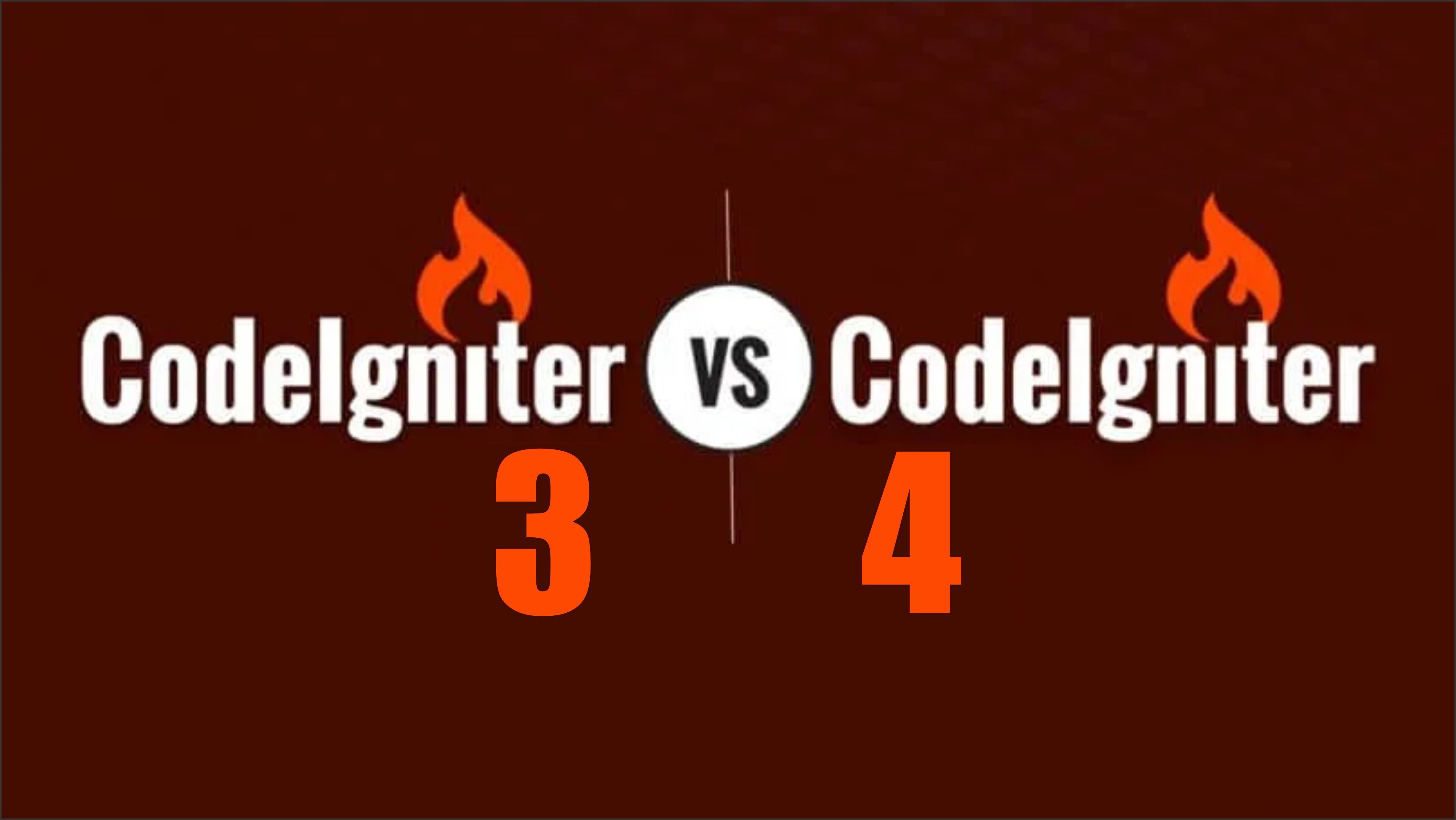
08
OctDifference Between CodeIgniter 3 and CodeIgniter 4
CodeIgniter is one of the most popular PHP frameworks used by developers to build web applications quickly and efficiently. Over the years, CodeIgniter has undergone significant updates and improvements, with the most notable being the transition from CodeIgniter 3 to CodeIgniter 4. This change brought about several major updates that addressed modern development needs and trends.
In this blog, we will take a closer look at the key differences between CodeIgniter 3 and CodeIgniter 4, highlighting how the framework has evolved and what benefits developers can expect when migrating or choosing between the two.
1. Framework Architecture and Design
One of the most significant differences between CodeIgniter 3 and CodeIgniter 4 lies in their architecture and design philosophy.
CodeIgniter 3:
Legacy Framework: CodeIgniter 3 is a legacy PHP framework, and its structure is more traditional. It was designed to work with PHP 5.2.4 and later, which limits its ability to take full advantage of modern PHP features.
Monolithic Design: In CodeIgniter 3, everything is relatively tightly coupled. Although the framework follows the MVC (Model-View-Controller) pattern, it lacks some of the modularity and flexibility of more modern frameworks.
CodeIgniter 4:
Modern Framework: CodeIgniter 4 was completely rewritten from the ground up to align with modern PHP development standards and practices. It requires PHP 7.2 (or higher), which allows it to utilize the latest PHP features such as type hinting, scalar types, and return type declarations.
Modular Structure: CodeIgniter 4 introduces a more modular architecture. It encourages developers to build reusable modules and libraries, offering greater flexibility and better code organization.
PSR Standards: CodeIgniter 4 adheres to PHP-FIG standards like PSR-4 for autoloading, PSR-1 for basic coding standards, and PSR-2 for coding style. This ensures better compatibility with third-party libraries and modern tools like Composer.
2. Routing System
Routing is a key part of any MVC framework, as it controls how requests are handled and routed to the appropriate controller methods. The routing system in CodeIgniter 4 has seen a significant upgrade over CodeIgniter 3.
CodeIgniter 3:
Basic Routing: CodeIgniter 3 uses a simple routing mechanism. It supports basic routing, where you define the controller and method directly in the URL.
Limited Flexibility: While functional, CodeIgniter 3’s routing system lacks the advanced capabilities needed for complex applications, such as named routes and route grouping.
CodeIgniter 4:
Improved Routing: CodeIgniter 4 offers a more robust and flexible routing system. It supports features like:
Named Routes: Developers can assign names to routes, which makes it easier to generate URLs programmatically.
Route Grouping: This allows related routes to be grouped together, simplifying route management and improving code organization.
Route Filters: You can now apply filters (such as authentication checks or input validation) to specific routes.
The routing improvements in CodeIgniter 4 make it more suitable for large-scale applications and provide developers with more control over how URLs are managed.
3. Configuration and Environment Handling
Handling different environments (development, testing, production) is crucial for web applications, as each environment might require different settings or behaviors. CodeIgniter 4 introduces a more structured way to manage configuration files.
CodeIgniter 3:
Single Configuration File: CodeIgniter 3 relies on a single configuration file, which may not be ideal for managing multiple environments. It requires developers to manually change configuration values when switching environments.
CodeIgniter 4:
Environment-Specific Configuration: CodeIgniter 4 introduces environment-based configuration. Developers can create separate configuration files for each environment (development, testing, production), making it easier to switch between environments without manually updating the configuration.
.env File Support: CodeIgniter 4 also adds support for the .env file, a standard way to store environment variables. This allows developers to configure their applications in a more secure and flexible manner.
The addition of environment-based configuration and .env file support in CodeIgniter 4 is a major improvement for developers who need to manage multiple environments efficiently.
4. Database Handling and Query Builder
CodeIgniter’s query builder provides a simplified way of interacting with databases without needing to write raw SQL queries. Both versions of CodeIgniter offer robust support for database operations, but CodeIgniter 4 introduces several enhancements.
CodeIgniter 3:
Basic Database Handling: CodeIgniter 3 provides a solid query builder with basic support for database operations like SELECT, INSERT, UPDATE, and DELETE.
Limited Features: While effective for most applications, CodeIgniter 3’s query builder lacks support for advanced features like JOINs and subqueries, making it less suitable for complex database interactions.
CodeIgniter 4:
Enhanced Query Builder: CodeIgniter 4’s query builder is more powerful and flexible, offering support for more complex SQL queries, including JOINs, subqueries, and transactions.
Migrations and Seeders: CodeIgniter 4 introduces migrations and seeders, which allow developers to manage database schema changes and seed their database with test data. This helps in version-controlling the database schema and managing updates across different environments.
Entity Class: CodeIgniter 4 also adds an Entity class, which is a useful tool for managing data objects more effectively and enforcing data integrity.
These database-related enhancements make CodeIgniter 4 better suited for applications that require complex database interactions and scalable database management.
5. Performance Improvements
Performance is a critical aspect of any web framework, especially for applications with high traffic. CodeIgniter 4 brings several performance enhancements compared to CodeIgniter 3.
CodeIgniter 3:
Standard Performance: CodeIgniter 3 is known for its lightweight structure and decent performance. However, it lacks some of the optimizations that are necessary for handling modern web applications with high performance demands.
CodeIgniter 4:
Optimized for PHP 7+: CodeIgniter 4 is optimized to take advantage of PHP 7 and newer versions, which offer significant performance improvements over PHP 5.x. Features like improved memory management, faster execution times, and better handling of asynchronous processes make CodeIgniter 4 more efficient.
Caching System: CodeIgniter 4 introduces a more flexible and powerful caching system, allowing developers to cache different parts of the application to improve performance.
The performance improvements in CodeIgniter 4 make it a more suitable choice for developers looking to build fast and scalable applications.
6. Security Enhancements
Security is always a top priority for web applications, and CodeIgniter 4 brings several security improvements over CodeIgniter 3.
CodeIgniter 3:
Basic Security Features: CodeIgniter 3 provides basic security measures such as CSRF (Cross-Site Request Forgery) protection, XSS (Cross-Site Scripting) filtering, and input data validation. However, some of these features require manual configuration, which can be error-prone.
CodeIgniter 4:
Enhanced Security: CodeIgniter 4 builds upon the security features of CodeIgniter 3 and introduces more robust default settings. It offers stronger encryption, improved CSRF protection, and better password handling with support for PHP’s password hashing functions.
Improved Validation: CodeIgniter 4’s validation system is more comprehensive, offering additional validation rules and the ability to easily define custom rules.
The enhanced security features in CodeIgniter 4 provide better protection for modern web applications, reducing vulnerabilities and ensuring safer development practices.
7. Testing Capabilities
Testing is an essential part of modern development workflows, and CodeIgniter 4 offers better support for automated testing compared to its predecessor.
CodeIgniter 3:
Manual Testing: CodeIgniter 3 does not provide built-in support for automated testing, which means developers often have to rely on external tools or manual testing methods.
CodeIgniter 4:
Integrated Testing Support: CodeIgniter 4 comes with built-in support for unit testing. It integrates with PHPUnit, a popular testing framework, allowing developers to write and run tests easily. This ensures that developers can catch bugs early in the development process and maintain high code quality.
The testing capabilities in CodeIgniter 4 make it a more robust framework for developers looking to build maintainable and scalable applications.
8. Documentation and Learning Curve
CodeIgniter 3:
Simplified Documentation: CodeIgniter 3 is known for its clear and straightforward documentation, making it easy for beginners to learn and get started with the framework. The simplicity of CodeIgniter 3 has contributed to its popularity among developers who are new to PHP frameworks.
CodeIgniter 4:
More Comprehensive Documentation: While CodeIgniter 4 maintains its tradition of clear documentation, it is more detailed and comprehensive due to the addition of new features and functionality. However, this also means that the learning curve for CodeIgniter 4 is steeper than for CodeIgniter 3, especially for beginners or developers who are accustomed to the simplicity of earlier versions.
Conclusion
CodeIgniter 4 is a major upgrade over CodeIgniter 3, offering a modern, modular, and feature-rich framework that meets the demands of contemporary web development. The new version introduces improvements in routing, database handling, performance, security, testing, and more, making it a compelling choice for developers building modern web applications.
For developers currently using CodeIgniter 3, migrating to CodeIgniter 4 may require some effort, but the benefits in terms of performance, security, and maintainability make the transition worthwhile. Developers who are starting new projects should strongly consider using CodeIgniter 4 to take advantage of its modern features and capabilities.
Author -

Sr. Software Developer

